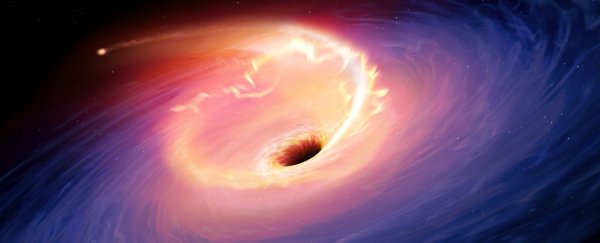It's one of the most violent endings in the cosmos: a star wandering too close to a supermassive black hole is torn asunder by its colossal gravitational forces.
When a star gets pulled apart like this, it's called a tidal disruption event (TDE), and scientists have now found evidence that this kind of stellar death could be a whole lot more common than we ever realised.
Up until now, TDEs had only ever been observed in sky surveys gazing at huge star systems encompassing thousands of galaxies. Because of this, astronomers thought that these extreme events were incredibly rare – perhaps occurring only once in a galaxy every 10,000 to 100,000 years.
But a team from the University of Sheffield in the UK has found signs of what they think is a TDE taking place in a much smaller sky survey of just 15 galaxies over a 10-year period.
If they're right, this chance detection suggests that TDEs could be 100 times more frequent than we previously estimated – that is, provided certain conditions are satisfied.
"Each of these 15 galaxies is undergoing a 'cosmic collision' with a neighbouring galaxy," explains astronomer James Mullaney.
"Our surprising findings show that the rate of TDEs dramatically increases when galaxies collide. This is likely due to the fact that the collisions lead to large numbers of stars being formed close to the central supermassive black holes in the two galaxies as they merge together."
The team first observed these 15 colliding galaxies back in 2005, but when they took another look 10 years later, they noticed something unusual.
"[W]hen we observed the sample again in 2015, we noticed that one galaxy – F01004–2237 – appeared strikingly different," says one of the team, Rob Spence.
F01004–2237 is located some 1.7 billion light years from Earth, and it's what's called an ultra-luminous infrared galaxy – star systems that shine up to 1,000 times brighter in infrared than a galaxy like our Milky Way.
The reason for this intense brightness is because they actually represent the collision of two separate galaxies – with the merger increasing their rate of star formation (aka a starburst galaxy).
But the 2015 data didn't just show this expected level of intense brightness in F01004–2237, meaning something had happened to the galaxy since 2005.
"This led us to look at data from the Catalina Sky Survey, which monitors the brightness of objects in the sky over time," says Spence.
"We found that in 2010, the brightness of F01004–2237 flared dramatically."
According to the team, that flare wasn't a supernova, and it also didn't look like the light show you'd see when smaller amounts of matter heat up as they fall into a supermassive black hole. Instead, it was characteristic of a TDE.
If they're right, it's possible that TDEs are a lot less rare than we thought – but not everybody is sure that the limited data we have for F01004–2237 actually confirms what the team is suggesting.
"First, let me say that finding a TDE in a starburst galaxy, as these authors seem to have done, is an important discovery, as it has never been seen before," astrophysicist Nicholas Stone from Columbia University, who wasn't involved with the study, told Gizmodo.
"However, I think more follow-up observations may be necessary to confirm this TDE candidate as a true TDE."
If subsequent observations can confirm this is indeed a TDE, then the implications could be major.
It might mean that these violent star deaths are a more commonplace phenomenon due to galaxy mergers – which could teach us new things about the formation of supermassive black holes themselves.
"[W]ith TDEs more common than previously thought, it may be that up to a quarter of the mass of a black hole could [be] accumulated via the swallowing of stars," Mullaney told Rosalie Chan at Inverse.
We'll have to wait and see what future research has to say about this hypothesis, but for their part, the researchers are in no doubt about the bright light emanating from F01004–2237.
"To make helium 'glow' like this requires extreme amounts of energy," Mullaney says.
"Only a few processes can provide this much energy on galaxy-scales, such as stars exploding as supernovae or TDEs. In our case, the way in which [the] galaxy has 'flared' has ruled out a supernova, leaving the TDE as the only possible alternative."
The findings are reported in Nature Astronomy (link down at time of writing).
